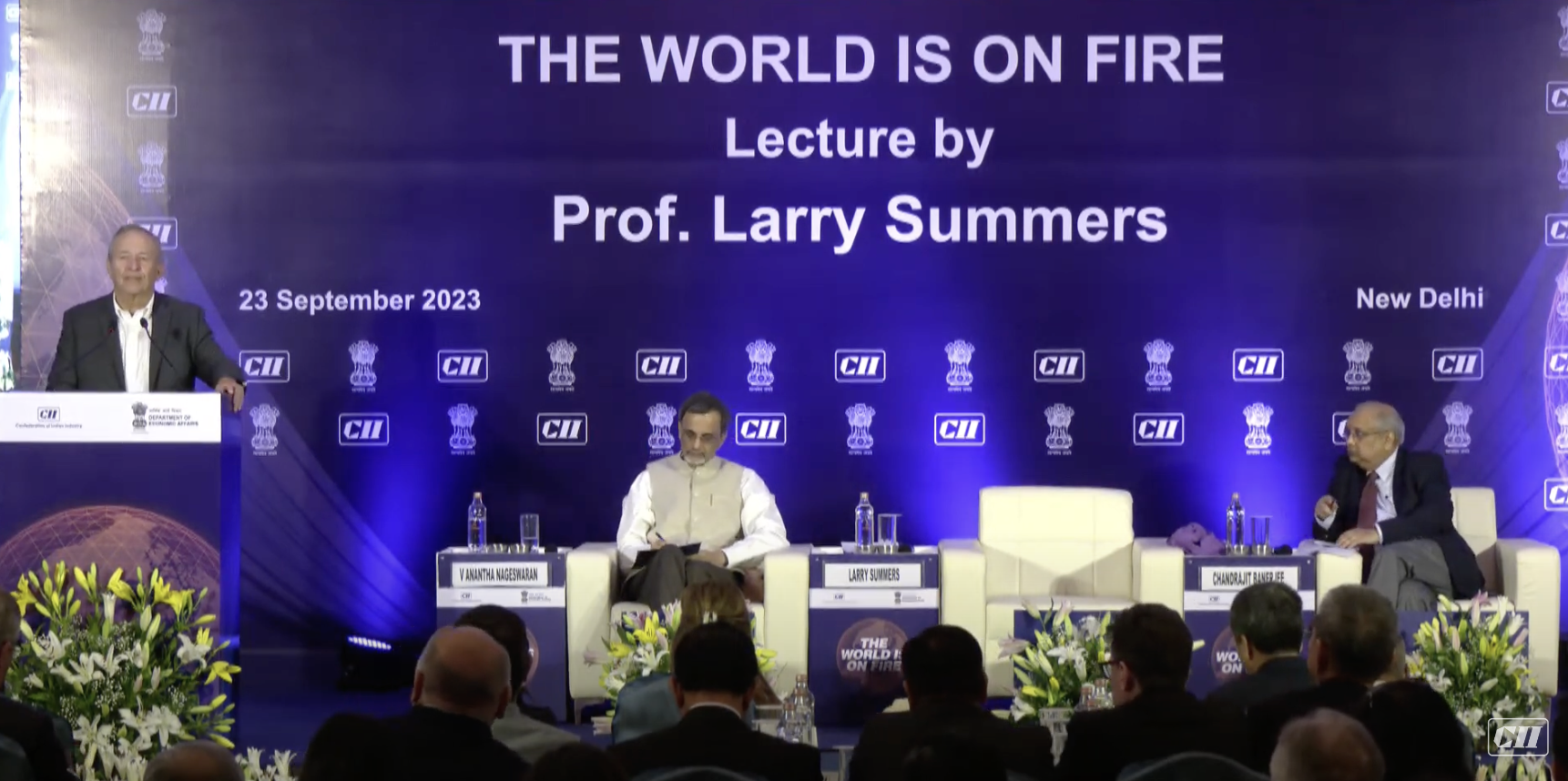Recommended
This blog post was published jointly with the Brookings Institution, as part of its Future of Development commentary series.
Under the Indian presidency, the G20 tasked N.K. Singh and Larry Summers to convene an independent expert group (IEG) to recommend how to strengthen multilateral development banks (MDBs) and address the shared global challenges of the 21st century (disclosure: we were both part of the Secretariat supporting the group). Volume 1 and Volume 2 of the IEG’s report have been welcomed by G20 Finance Ministers meeting at Marrakech, as well as by MDBs themselves.
These volumes recommend radical reform of the MDBs involving hard trade-offs but leaving everyone better off if the package is adopted in its entirety. It is not an ambitious agenda but simply what is needed. The biggest risk today is that piecemeal reforms will move ahead but momentum for radical reform will be lost.
We believe the best way to guard against this risk is to build as large a coalition as possible to advocate for change amongst shareholders, MDB management and staff, borrowing governments, and other development and climate stakeholders. To that end, we take seriously all commentary on the report. In the spirit of advancing the dialog, we offer the following reactions to criticisms we have heard.
-
Issue: Focus on climate action represents a misallocation of development resources. Bjorn Lomborg, among others, has argued that for most developing countries a focus on climate action is misplaced and that the highest development bang-for-the-buck comes from investments in nutrition and public health.
Response: First, the choices on where to invest should be made by each country rather than imposed by a set of experts. The fact is that developing country governments have expressed a desire to invest in climate action through their Nationally Determined Contributions submitted to the UNFCCC and these governments are asking MDBs to help with implementation.
Second, the kind of marginal cost-benefit analysis used by Lomborg is fraught with problems when it comes to assessing climate action and the system change that is needed. Many of the country requests for MDB investment are for adaptation and resilience whose benefits depend on an understanding of the frequency and magnitude of natural disasters in the future. Guarding against these tail risks is well worth the effort, as the late Marty Weitzman has argued.
Marginal cost-benefit analysis can be a place from which to start the decision-making process but cannot be the only consideration. No one would argue that construction of all schools should be put on hold until all unmet health and nutrition needs were satisfied.
-
Corruption in developing countries should be tackled first. World Politics Review says that corruption should be tackled before embarking on large-scale infrastructure in developing countries, citing U.N. estimates that corruption is costing $2.6 trillion per year, and Transparency International’s finding that most governments, especially populists, are seen as corrupt by their own citizens.
Response: Reducing corruption is a needed step and there are significant efforts to define and enhance “quality” infrastructure. The Blue Dot Network, for example, is a mechanism launched by the United States, Japan, Australia, the United Kingdom, and Spain to certify infrastructure projects meeting quality standards. The OECD (Organisation for Economic Cooperation and Development) successfully completed road-testing the framework on energy, transport, water, and ICT (Information and Communication Technology) projects in different regions in February 2023.
Tackling corruption is necessary, and aided by citizen engagement, but waiting for it to be eliminated before embarking on much-needed infrastructure is no way to help vulnerable people.
-
Issue: Fixing the policy environment and encouraging private finance should come before more official financing. Frank Lysy and others have argued that “whatever funding might conceivably be raised via the multilaterals and other official sources would not come anywhere close to what will be required to address climate change… The policy environment will be key, and the World Bank could be central in providing assistance on this - provided it has staff with the skills required. Financing would then follow. However, the sequence has typically been the reverse, with funding put first.”
One implication of this assessment is that the focus on MDB financing is misplaced because MDBs are such a small part of the total financing needed. Instead, more emphasis should be placed on encouraging private financing flows which may or may not involve the MDBs.
Response: We agree completely that without a sharp scaling-up of private financing, financing from the MDBs would fall well short of needs, and the report argues that MDBs should set ambitious mobilization ratios. We also see the need for MDBs to help countries create appropriate enabling environments for the private sector. However, we do not view sequencing as a first-order issue, nor do we believe that a focus on private finance means a reduced focus on official finance. Both policy improvements and new financing are sorely needed. The urgency of the moment suggests we cannot wait for policy improvements before tackling new investments. At the same time, the IEG report places a heavy emphasis on the need to pay attention to the Cascade principles and avoid official finance crowding-out of the private sector.
We agree with Lysy that the comparative advantage of the MDBs, when private financial returns are attractive relative to risks, is in technical assistance to improve the regulatory and policy framework, but also believe MDBs must provide guarantees in non-investment-grade countries to encourage private capital flows to these countries. We also emphasize that along with such efforts, there is a corresponding need for MDB financing support in areas that do not have sufficient financial returns—many adaptation, resilience, and nature-based investments fall under this category. The disaggregation of investments in terms of their social and financial returns and risks is a fundamental element of our analysis of where MDB comparative advantage should lie.
-
Issue: Are the numbers in the IEG report realistic? Ajay Chhibber argues in The Economic Times that the report lacks fair and automatic mechanisms, and that the proposed $2 trillion increment in domestic financing (DRM) is not fair. He is also skeptical as to whether the MDBs can respond adequately on the scale that is needed.
Response: Our analysis starts with the size of needed investments, which Chhibber does not question. The financing requirements are derived from this. We divide total financing into a domestic and external portion. The latter is then subdivided into components, and the appropriate share of the MDBs is computed. The numbers reflect what is necessary and our objective is to shift the political discourse to recognize this, rather than taking as given existing political positions.
We believe both the investment and financing numbers can be realized. On the domestic front, there are multiple avenues to be explored. First, shifting to green energy investments carries with it a shift away from dirty energy investments. It is important not to confuse the gross investment numbers we put forward with net investment increments. Second, there are significant subsidies that are inefficient and that can potentially be re-oriented to more effective investments. The IMF argues that “The revenues generated by full price reform in 121 EME and developing countries in 2030 would amount to $3 trillion, which is broadly in line with their additional spending needs for Sustainable Development Goals. A partial price reform results in about two-thirds of the revenue gain.” It is this two-thirds figure, equivalent to $2 trillion, that is used in the IEG report for domestic mobilization.
DRM would be enhanced if MDBs worked more with national development banks and other local institutional investors. Viewed in this way, raising domestic finance is not placing an unfair burden on countries, but is an essential component to reduce the foreign exchange risk that accompanies sustainable infrastructure projects.
-
Issue: The MDBs are too bureaucratic to reform. New institutions are needed. Hafez Ghanem, Ken Rogoff, and others have argued for the creation of a Green Bank or a World Carbon Bank on the grounds that MDBs have failed to deliver on climate change, and lack the legitimacy needed in terms of governance to address issues of concern to the Global South. In this view, MDBs are large bureaucracies, incapable of change, so they will just try to continue doing what they do.
Response: We are sympathetic to the idea that it will be hard to change MDBs but feel there is no realistic alternative. MDBs must be made to change. And while it is easy to call for setting up new institutions, it is almost inconceivable that in the current geopolitical context the international community could reach a consensus on mandate, ownership, governance, operating models, and financing. At best, this is a multiyear endeavor and time is running out. It took three years to establish the Asian Infrastructure Investment Bank after it was first proposed by Xi Jinping in 2013. AIIB is only now starting to achieve scale ($4.3 billion in non-COVID-19 financing in FY22) and many of its projects are co-financing with other MDBs. Other new international institutions, such as the Green Climate Fund, have not been able to achieve significant scale.
More substantively, separating climate from development finance is conceptually and practically impossible. Consider the case of sustainable infrastructure in coastal cities. There, a new agenda is emerging of designing public spaces like parks and lakes to absorb and store water during flood episodes, as well as improvements of drainage. Trying to distinguish whether such investments should be done by a “climate” bank or a “development” bank makes no sense. Similarly, most elements of resilience involve strengthening social protection, a quintessential “development” activity. In both examples, MDBs have considerable experience that a new institution would find hard to replicate.
Despite the criticisms, there is now momentum behind MDB reform. A roadmap for change has been laid out. Indeed, one reason we are more hopeful that significant reforms will be implemented this time round is that the IEG report spells out 30 quantitative recommendations that can be tracked.
We are not complacent about the challenges to maintain reform momentum. On the contrary, we invite all interested parties to monitor the pace and scope of implementation by each MDB. For our part, we will report on progress after six months and 12 months from the report’s launch. And the Center for Global Development has launched an MDB Reform Tracker which monitors and reports progress and will be updated bi-annually.
Implementation has now shifted from a global ministerial forum to the boards of each MDB. It is critical they demonstrate the same level of ambition and urgency. We are also very conscious of the nascent state of mobilizing more funding for MDBs. There have been one or two encouraging initiatives to provide hybrid capital and guarantees but these need to be brought to fruition and scaled up. Reform and funding will need to move hand-in-hand, and both must show the level of ambition that is warranted by scale and urgency of development challenges.
Disclaimer
CGD blog posts reflect the views of the authors, drawing on prior research and experience in their areas of expertise. CGD is a nonpartisan, independent organization and does not take institutional positions.
Image credit for social media/web: zephyr_p / Adobe Stock








